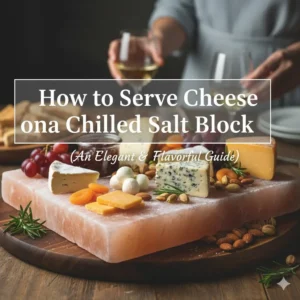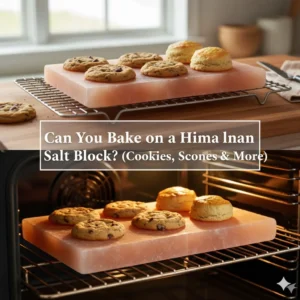Dry aging steak is a controlled process that enhances flavor and tenderness by allowing natural enzymes to gradually break down muscle fibers under precise humidity and temperature conditions. Himalayan salt blocks add measurable value by stabilizing moisture levels and purifying the air inside a dedicated refrigerator or charcuterie chamber. This article explains how these salt blocks optimize the dry-aging environment and provides a clear, step-by-step guide for achieving professional results at home.
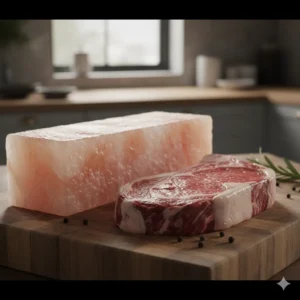
Prerequisites: Essential Tools and Materials
Before beginning the dry aging process with Himalayan salt blocks, ensure you have equipment that supports safe, stable, and hygienic conditions. Each tool contributes to precise humidity management, temperature regulation, and meat protection—all vital for developing flavor complexity and tenderness.
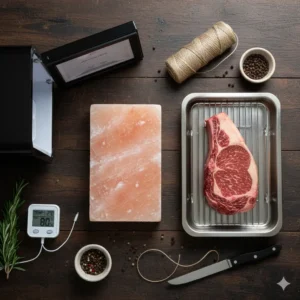
- High-quality Himalayan salt blocks from reputable suppliers to ensure consistent humidity control and verified mineral purity.
- A dedicated refrigerator or temperature-controlled mini-fridge capable of maintaining a steady 1–3 °C (just above freezing).
- Well-marbled beef cuts such as ribeye or strip loin, preferably bone-in with a protective fat cap for optimal aging performance.
- Supporting equipment including stainless steel trays, wire racks for airflow, a reliable meat thermometer, and a sanitized workspace.
- Time and patience to allow enzymatic processes to enhance flavor depth and achieve a restaurant-quality texture.
Premium Himalayan Salt Blocks for Culinary and Hospitality Professionals
Source genuine pink Himalayan salt from the Khewra Salt Mine, rich in more than eighty natural minerals. Ideal for grilling, searing, chilling, or refined presentation, these customizable blocks meet both FDA and EU food safety standards. Designed for chefs, retailers, and hospitality specialists, each piece delivers a balance of natural elegance and dependable performance in both kitchen and display environments.
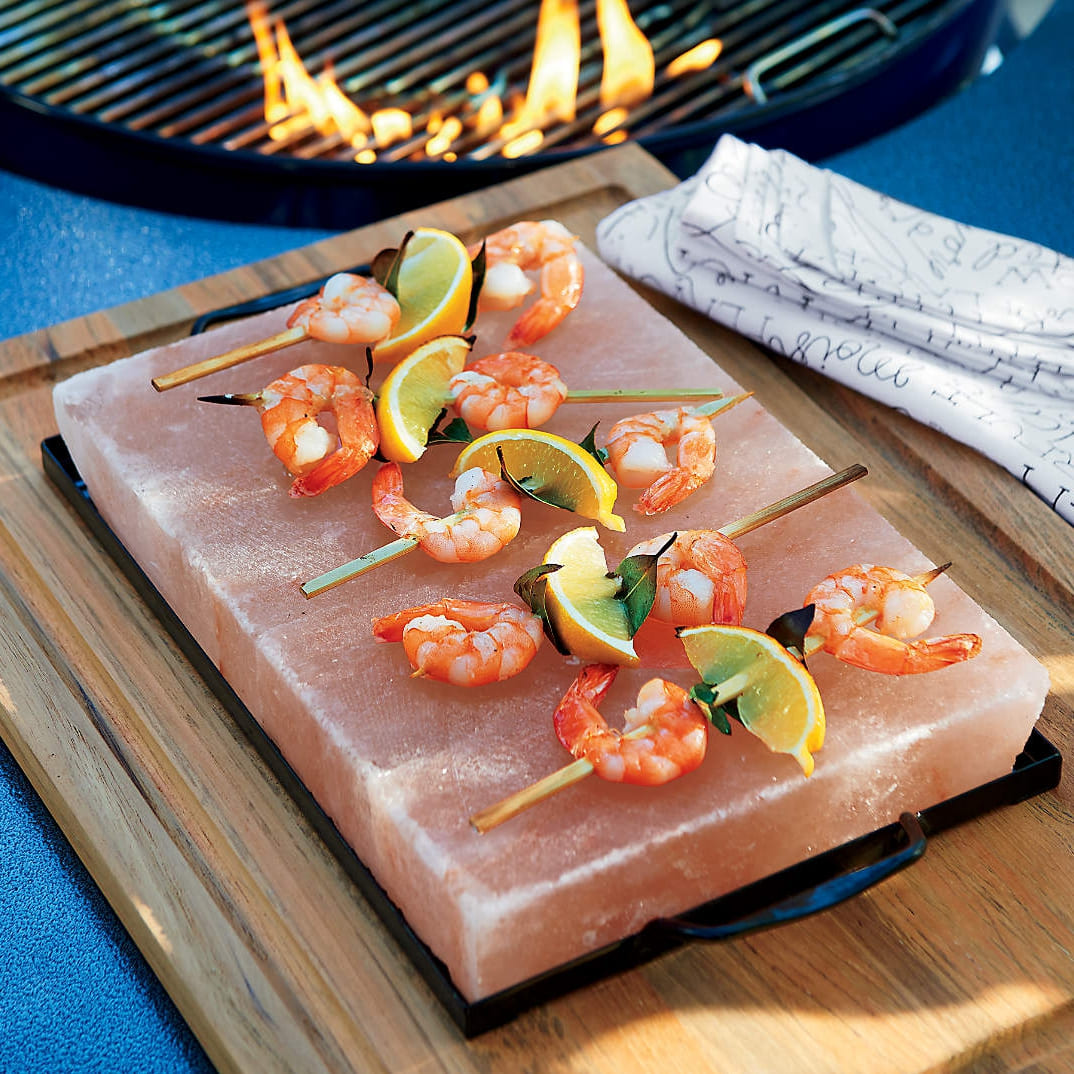
Step-by-Step Guide to Dry Aging Steak with Himalayan Salt Blocks
Step 1: Prepare the Dedicated Aging Environment
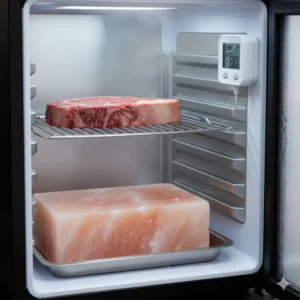
Begin by creating a controlled space solely for dry aging. Clean and sanitize a spare refrigerator or mini-fridge to prevent cross-contamination. Line the shelves or interior walls with Himalayan salt blocks; they function as natural humidity regulators and gentle air purifiers. Maintaining humidity near eighty percent keeps the beef from drying too quickly while limiting bacterial growth.
Allow the salt to stabilize overnight so it can balance moisture levels evenly. Use digital temperature and humidity meters to confirm steady readings before adding the meat. This preparation establishes a clean, enzyme-friendly microclimate where the steak’s natural aging process can progress safely.
Step 2: Select and Prepare the Beef Cut
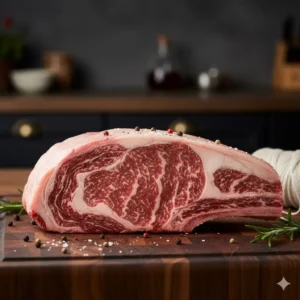
Choose a prime or choice-grade cut with generous marbling and a protective fat cap. Ribeye, sirloin, and striploin are ideal because their composition supports even aging and moisture retention. Trim only thick, excess fat, leaving enough coverage to shield the surface during the process.
Do not salt or vacuum-seal the meat beforehand, as consistent airflow is essential. Place the beef on a wire rack positioned above the salt blocks to maintain even circulation. The surrounding salt-rich air subtly seasons the exterior while allowing internal enzymes to intensify flavor and tenderness.
Step 3: Monitor and Maintain the Aging Process
Once the meat is positioned, keep the refrigerator temperature between 34–38 °F (1–3 °C) and humidity close to eighty percent. Check readings daily to prevent fluctuations. If one side appears drier, rotate the meat periodically to promote uniform results.
Monitor the aroma and surface condition. A mild, earthy scent and small white mold patches are typical and can be trimmed later. Depending on your desired flavor intensity and texture, dry aging can last from two to six weeks.
Step 4: Finish and Cook
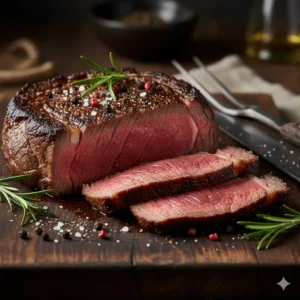
When aging concludes, remove the beef and trim away the darkened outer layer along with any mold. The interior should be firm, richly colored, and pleasantly aromatic. Pat the meat dry with paper towels to achieve a clean sear.
Because the steak has absorbed trace minerals from the salt environment, additional salting isn’t necessary before cooking. Sear or grill over high heat, then rest before slicing. The result is a richly flavored, tender steak that embodies the balanced aging environment created by Himalayan salt blocks.
How Himalayan Salt Blocks Enhance Dry Aging
Himalayan salt blocks unite scientific precision with traditional craft in the dry-aging process. Their dense mineral composition regulates humidity by absorbing and releasing moisture, maintaining an ideal microclimate for safe enzymatic activity. This controlled environment ensures that beef matures evenly without drying excessively or fostering unwanted bacteria.
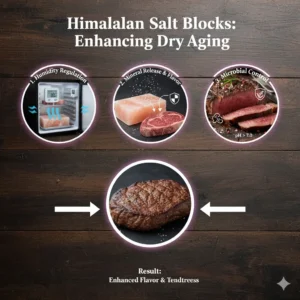
In addition to stabilizing humidity, the blocks contribute subtly to flavor development. Trace minerals such as calcium, iron, and potassium lend a gentle savory depth that enhances the meat’s natural umami without overpowering it. The salt’s intrinsic antimicrobial properties also promote a cleaner surface and more consistent results than typical air-aging methods.
For home aging chambers or charcuterie refrigerators, Himalayan salt delivers both function and aesthetic value. Its translucent pink tone and crystalline structure elevate the presentation while sustaining the precise conditions needed to produce premium dry-aged beef.
Selecting the Ideal Beef Cut for Dry Aging
Choosing the proper cut is essential for effective dry aging, particularly when working with Himalayan salt blocks in a dedicated refrigerator. Bone-in sections such as ribeye or strip loin perform best because the bone protects the muscle and intensifies flavor as it matures. The mineral balance from the salt maintains consistent humidity, allowing these cuts to develop rich, nutty complexity without losing moisture.
Prioritize beef with ample marbling, as intramuscular fat melts gradually and preserves juiciness throughout the aging process. Steer clear of thin or very lean cuts; they dehydrate quickly and gain limited benefit from the salt’s controlled microclimate. For home aging, purchasing a larger primal cut and trimming it after maturation produces more uniform results and minimizes waste during crust removal.
Common Challenges and How to Avoid Them
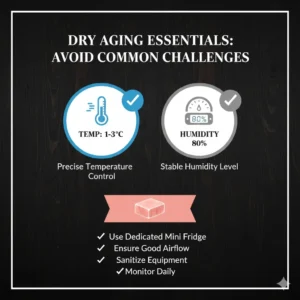
Even with correct equipment and preparation, home dry aging can falter if conditions fluctuate. Himalayan salt blocks help regulate humidity and air quality, but consistent monitoring remains essential. The table below outlines typical issues and proven solutions to keep aging conditions stable and ensure the beef develops the desired flavor and tenderness.
| Common Mistake | How to Avoid It |
|---|---|
| Excess moisture leading to spoilage or off odors | Keep humidity near 80% using Himalayan salt blocks and verify readings regularly with a hygrometer. |
| Temperature fluctuations compromising safety | Use a dedicated refrigerator with a stable thermostat set between 1 °C and 3 °C. |
| Placing meat directly on the salt block causing excess salt absorption | Always position the beef on a wire rack or tray to ensure adequate airflow and prevent direct salt contact. |
| Neglecting mold or surface contamination | Inspect the meat weekly, trimming away any hard or moldy crust to maintain food safety. |
| Expecting tenderness improvements with insufficient aging time | Allow a minimum of two weeks for enzymatic tenderization; four to six weeks yield more pronounced results. |
Maintaining a stable microclimate within the dry-aging refrigerator is the strongest safeguard against spoilage. With balanced humidity, consistent airflow, and patience, natural enzymes can refine both texture and flavor to produce exceptional steak quality.
Frequently Asked Questions About Himalayan Salt Block Dry Aging
Should the steak rest directly on the salt block?
It can, provided the setup is designed for direct contact. Placing the steak on the salt block allows gentle moisture withdrawal and helps stabilize humidity, enabling enzymes in the beef to work effectively throughout the aging period.
How many Himalayan salt blocks are needed for an effective dry-aging setup?
The quantity depends on the interior size of your refrigerator or chamber. Most home users position one or two large blocks along the base or sides to regulate humidity. Broader coverage creates a more stable environment, but maintaining ample airflow around the beef is equally important.
Will dry aging with salt blocks make the steak overly salty?
No. The salt block does not oversaturate the meat with sodium. Instead, it imparts trace minerals and promotes flavor concentration through controlled dehydration. Its primary influence lies in maintaining ideal moisture levels rather than direct seasoning.
Is it safe to dry age beef at home using Himalayan salt blocks?
Yes, when temperature, airflow, and humidity are carefully maintained. Himalayan salt assists by absorbing excess moisture and reducing bacterial growth, but food safety ultimately depends on consistent refrigeration, proper air circulation, and hygienic handling.
How does this method differ from simply salting the steak surface?
Surface salting provides immediate seasoning, while salt block dry aging shapes the environment over several days or weeks. The block regulates humidity and purifies the air, fostering gradual enzyme activity that develops tenderness and complex flavor depth.
Final Thoughts
Using Himalayan salt blocks for dry aging creates a naturally balanced environment inside your refrigerator. The salt stabilizes humidity and air purity, enabling the beef’s enzymes to tenderize the meat while developing a deep, concentrated flavor. The process rewards precision and patience, producing results that reflect careful control of every variable.
Maintaining a consistent temperature, humidity, and hygienic workspace is essential throughout the aging period. Home cooks who execute these fundamentals effectively can achieve steak quality comparable to premium restaurants—richly textured, aromatic, and full of character.
After each use, store the salt blocks clean and dry, and experiment with different aging durations to tailor flavor intensity. Each cycle reveals new nuances in how mineral-rich salt and time work together to transform beef into an exceptional culinary experience.




